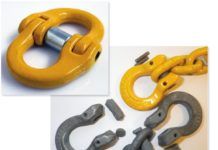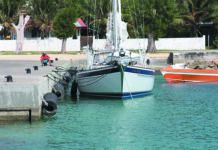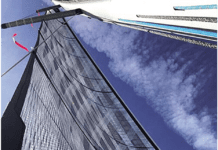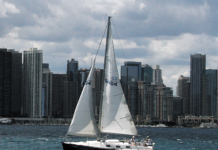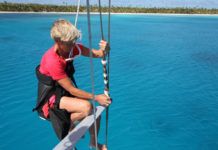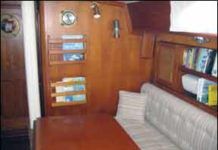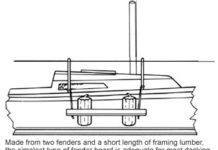Former Marketing Director, CR38 Owner Offers His 2 Cents
Practical Sailor reader Allen Taylor so loved his Cabo Rico 38 that he eventually started working for the company as the marketing director. Now, with his stint at Cabo Rico far behind him, the former marketing director offered this insightful view of the Crealock 38, which he lived on and cruised for several years. Although he still holds the boat in high esteem, he offered this list of potential trouble spots.
Alberg Owners Love Their A35s, Warts and All
Nearly every owner we spoke to about their Alberg 35 had small gripes about the boats performance, cosmetic defects, and outdated equipment. Nevertheless, it was clear that each had great confidence in the hull design and construction, and took pride in the boats enduring classic aesthetics.
Deck, Hull-to-deck Joint, and Keel Merit a Close Look
As is typical of C&Cs, owners give the boat high marks for quality of construction, and in general, their enthusiasm is justified. The boat does, however, have a potential weak point. Hull: Like most C&Cs, the 40 was built with a balsa-cored hull. The result is a hull that is extremely stiff for its weight, but balsa coring is not without its potential for problems. In the event of delamination or rupture of the hull skin, the balsa coring can absorb moisture. Moisture penetration of the outer laminate could ultimately reach the balsa coring. It is imperative that a balsa-cored hull be carefully examined by a knowledgeable surveyor before purchasing a used boat.
Used Boat Review: LM32 Pilothouse Sloop
Danish company LM (Lunderskov Mbelfabrik) began as a wood furniture maker in 1940. In the 1950s, the company incorporated the newfangled fiberglass into their furniture, and in 1972, the company built its first fiberglass sailboat, the LM27. Over the next 20 years, it built 3,000 boats in five models, ranging from 24 to 32 feet. All LM models share a similar look-canoe-stern hulls with a pilothouse ahead of a sizable cockpit. All are mast-head rigged sloops, and every owner we talked to said that the boats sailed better than they expected-an experience that we shared on our test sail of the LM32.
Financing Good Ole Boats
Here is a question that has puzzled me for a long time. Many financial institutions offer financing on mature vessels but have a boat age limit of 15 to 20 years. But, if a 1978 classic-plastic boat underwent a major refit in, say 1999, does that make the boat a 1999 in the eyes of the financiers? Id like to hear tales on how others may have gotten around this rule.
Boat Test: The Last Sabre 34 Mark II
In 1985, after nearly a decade of building the popular Sabre 34, Sabre Yachts significantly revamped the design. The resulting boat-beamier, roomier, faster, and more powerful than the original-is usually referred to as the Sabre 34 Mark II. The Mark II, like its predecessor, still hews the performance-cruising line that Sabre established with the introduction of its very first boat, the Sabre 28, in 1971. The Sabre 34 Mark II is not without quirks, but its many positives far outweigh its downsides.
Used Boat Review: Gulfstar 36
The Gulfstar 36, also called the Gulfstar 36 Auxiliary, was the smallest boat built by Gulfstar Yachts. Gulfstar, which produced 2,500 boats in the 1970s and 1980s, was launched by Vincent Lazzara, one of the early experts in fiberglass boat building. The Gulfstar 36 design is conservatively traditional-it was never called a racer-cruiser, but it was similar to many popular racer-cruisers and coastal cruisers of the time, with modest overhangs, a longish waterline, a moderately long fin keel, and a skeg-hung rudder. The designers are listed as R.C. Lazzara and David Jones.
Funding the Dream
In the June 2001 issue, Practical Sailor looked at financing boats and recommended that prospective boat buyers “stick with the pros.” We recently set out to see what had changed in boat financing since the 2008 U.S. financial crisis. After interviewing industry experts and related organizations on the state of the marine lending and boating industries, we assumed a boat-buyer’s role and sought financing help from marine loan specialists, large banks, and small lenders. We looked at cash versus financing, borrowing against your home, finance products, rates on boat loans, collateral on the loans, insurance issues, pre-approvals, repossession, and borrower qualifications.
A Practical Look at Sailboat Cockpit Design
A sailboat cockpits design and layout can determine the process of boat-handling tasks, including everything from steering and sail trimming to what goes on when its time to reef. Weve found that many cockpits are optimized for at-anchor enjoyment instead of underway usability, so boat shopping should include close scrutiny of how essential sailing and boat-handling tasks will be accomplished. Make sure that the cockpit of the boat you are about to buy is in keeping with the mission of the rest of the boat-whether youre a marina hopper, a club racer, or an offshore cruiser. Our recent survey of cockpits covers the highs and lows of cockpit design for various types of sailboats, and also includes a DIY guide to rating cockpit ergonomics to help your boat-shopping process.
Build Your Own Fender Boards
Fender boards are almost a necessity when docking against pilings because without them, no matter how you position and secure your boat and fenders, movement of tide and boat will displace the position of the fenders relative to the piles. The result dinged topsides.










